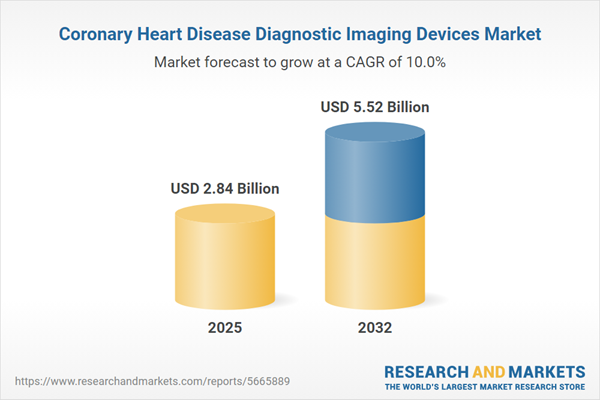Speak directly to the analyst to clarify any post sales queries you may have.
The Coronary Heart Disease Diagnostic Imaging Devices Market is positioned for significant advancement as healthcare systems demand more precise, efficient, and accessible cardiovascular diagnostics. This growth is shaped by continuous technological upgrades, evolving clinical workflows, and a heightened focus on improving decision-making for superior patient care.
Market Snapshot: Coronary Heart Disease Diagnostic Imaging Devices Market
The global coronary heart disease diagnostic imaging devices market expanded from USD 2.58 billion in 2024 to USD 2.84 billion in 2025, and is forecast to continue rising at a CAGR of 9.98%, ultimately reaching USD 5.52 billion by 2032. This market is propelled by increasing incidence of cardiovascular disease, need for advanced noninvasive diagnostics, and strong investments in imaging technologies. Vendors are leveraging innovation to meet growing clinical demand and optimize resource use, especially in high-throughput healthcare environments.
Scope & Segmentation
- Technology: CT (Dual-Source, Multi-Slice, Single-Slice), MRI (1.5T, 3T, Above 3T), Optical Imaging (IVOCT, NIRS), PET, SPECT, Ultrasound (2D, 3D, Doppler)
- End Users: Ambulatory Care Centers, Diagnostic Centers, Hospitals, Specialty Clinics
- Applications: Anatomical Assessment, Perfusion Imaging (Resting, Stress), Viability Imaging
- Region: Americas (North America: United States, Canada, Mexico; Latin America: Brazil, Argentina, Chile, Colombia, Peru); Europe, Middle East & Africa (Europe: United Kingdom, Germany, France, Russia, Italy, Spain, Netherlands, Sweden, Poland, Switzerland; Middle East: United Arab Emirates, Saudi Arabia, Qatar, Turkey, Israel; Africa: South Africa, Nigeria, Egypt, Kenya); Asia-Pacific (China, India, Japan, Australia, South Korea, Indonesia, Thailand, Malaysia, Singapore, Taiwan)
- Companies: GE Healthcare, Siemens Healthineers AG, Koninklijke Philips N.V., Canon Medical Systems Corporation, Fujifilm Holdings Corporation, Hitachi Ltd., Shimadzu Corporation, Carestream Health Inc., Agfa-Gevaert N.V., Esaote S.p.A.
Key Takeaways
- Adoption of advanced imaging platforms such as multi-slice CT and high-field MRI continues to streamline clinical workflows and improve diagnostic confidence in coronary heart disease.
- Artificial intelligence integration with imaging systems is enabling automation and predictive analytics, helping clinicians to quantify coronary lesions more consistently and efficiently.
- Portable and hybrid imaging solutions are increasing access to diagnostics in diverse healthcare settings, including remote and resource-limited regions.
- The push for personalized medicine drives upgraded imaging systems capable of combining anatomical and metabolic data, meeting the evolving demands of comprehensive cardiovascular assessment.
- Growing collaboration between manufacturers and software developers is leading to improved workflow, accelerated data interpretation, and enhanced connectivity across the healthcare landscape.
Tariff Impact: U.S. Trade Actions and Global Supply Chain Response
Newly implemented U.S. tariffs on imported diagnostic imaging components have introduced complexity to supply chains and pricing strategies. Manufacturers are re-evaluating sourcing strategies, considering nearshoring and diversifying suppliers to reduce exposure to trade risks. Distributors and healthcare providers are closely monitoring equipment costs and adapting procurement and contract management processes to maintain budget alignment without compromising on clinical quality. Collaborative manufacturing partnerships and pursuit of modular component platforms are also helping the industry mitigate uncertainty while supporting ongoing product innovation.
Methodology & Data Sources
This report utilizes a robust blend of primary and secondary research, including in-depth interviews with key stakeholders, industry expert consultations, and a comprehensive analysis of leading publications, regulatory announcements, and corporate filings. Data was triangulated through market mapping, hospital case studies, and review of regional procurement trends.
Why This Report Matters
- Gives senior decision-makers clear strategic direction based on holistic market, technology, and regional analysis.
- Highlights actionable competitive intelligence for market entry, product development, and investment planning in the coronary heart disease diagnostic imaging market.
Conclusion
The coronary heart disease diagnostic imaging devices market is entering a dynamic phase, marked by rapid technological advancement and strategic industry realignment. Leaders in this space who innovate, adapt to policy shifts, and collaborate with diverse partners are best positioned to deliver value-driven cardiac diagnostics across varied healthcare ecosystems.
Additional Product Information:
- Purchase of this report includes 1 year online access with quarterly updates.
- This report can be updated on request. Please contact our Customer Experience team using the Ask a Question widget on our website.
Table of Contents
3. Executive Summary
4. Market Overview
7. Cumulative Impact of Artificial Intelligence 2025
Companies Mentioned
The companies profiled in this Coronary Heart Disease Diagnostic Imaging Devices market report include:- GE Healthcare
- Siemens Healthineers AG
- Koninklijke Philips N.V.
- Canon Medical Systems Corporation
- Fujifilm Holdings Corporation
- Hitachi, Ltd.
- Shimadzu Corporation
- Carestream Health, Inc.
- Agfa-Gevaert N.V.
- Esaote S.p.A.
Table Information
| Report Attribute | Details |
|---|---|
| No. of Pages | 195 |
| Published | October 2025 |
| Forecast Period | 2025 - 2032 |
| Estimated Market Value ( USD | $ 2.84 Billion |
| Forecasted Market Value ( USD | $ 5.52 Billion |
| Compound Annual Growth Rate | 9.9% |
| Regions Covered | Global |
| No. of Companies Mentioned | 10 |









